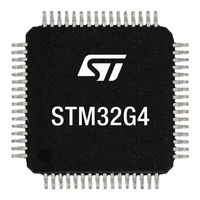ST STM32G474 Manuals
Manuals and User Guides for ST STM32G474. We have 3 ST STM32G474 manuals available for free PDF download: Reference Manual, User Manual
ST STM32G474 Reference Manual (2126 pages)
advanced Arm-based 32-bit MCUs
Brand: ST
|
Category: Microcontrollers
|
Size: 39.58 MB
Table of Contents
-
-
-
Bit Banding85
-
-
Introduction92
-
-
(Dbank=1)106
-
-
FLASH Interrupts126
-
FLASH Registers127
-
-
-
Introduction147
-
-
-
FLASH Interrupts172
-
FLASH Registers173
-
-
-
Introduction188
-
-
-
FLASH Interrupts213
-
FLASH Registers214
-
Table 43. Sleep246
-
Power Reset272
-
Reset272
-
System Reset272
-
Clocks274
-
RTC Domain Reset274
-
HSE Clock278
-
HSI16 Clock279
-
HSI48 Clock280
-
LSE Clock280
-
Pll280
-
LSI Clock281
-
ADC Clock283
-
And Transactions523
-
Trigger Occurs640
-
HRTIM = 170 Mhz852
-
(Timx_Arr Preloaded)1097
-
With Break Feature1201
-
(Timx_Arr Preloaded)1357
-
Feature (TIM15)1405
-
Preloaded)1453
-
Preloaded)1454
-
(M Bits =00)1623
-
(M Bits = 01)1624
-
(M Bits =00)1625
-
FIFO Disabled)1641
-
FIFO Disabled)1706
-
Figure 592. I1764
-
Figure 607. I1771
-
Nostretch= 11877
-
Nostretch=01877
-
(Max T IDLE = 50 Μs)1899
-
Table 424. Data Size2049
-
Debug Support2080
-
Advertisement
ST STM32G474 Reference Manual (2083 pages)
advanced Arm-based 32-bit MCUs
Brand: ST
|
Category: Microcontrollers
|
Size: 37.64 MB
Table of Contents
-
-
-
Bit Banding83
-
-
Introduction90
-
-
(Dbank=1)104
-
-
FLASH Interrupts124
-
FLASH Registers125
-
-
-
Introduction145
-
-
-
FLASH Interrupts170
-
FLASH Registers171
-
Table 33. Sleep203
-
Power Reset229
-
Reset229
-
System Reset229
-
Clocks231
-
RTC Domain Reset231
-
HSE Clock235
-
HSI16 Clock236
-
HSI48 Clock237
-
LSE Clock237
-
Pll237
-
LSI Clock238
-
ADC Clock240
-
RTC Clock240
-
Timer Clock241
-
Watchdog Clock241
-
Trigger Occurs600
-
(Timx_Arr Preloaded)1053
-
Is Not Used1198
-
(Timx_Arr Preloaded)1311
-
Feature (TIM15)1359
-
Preloaded)1407
-
Preloaded)1408
-
(M Bits =00)1582
-
(M Bits = '01')1583
-
(M Bits =00)1584
-
FIFO Disabled)1600
-
FIFO Disabled)1665
-
Figure 591. I1723
-
Nostretch= 01832
-
Nostretch= 11833
-
(Max T IDLE = 50 Μs)1856
-
Table 413. UCPD Pins2002
-
Table 418. Data Size2006
-
Debug Support2041
-
ST STM32G474 User Manual (83 pages)
25 kW, dual active bridge bidirectional power converter for EV charging and battery energy storage systems
Brand: ST
|
Category: Media Converter
|
Size: 9.65 MB
Table of Contents
Advertisement
Advertisement


